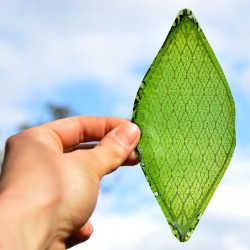
The ability of plants to put solar energy to work in highly efficient ways has long intrigued scientists and technologists. A combination of sunlight, water, and carbon dioxide provides the fuel they need to grow, flower and produce fruit. It's a highly efficient, non-polluting system.
Now researchers are turning to nature to provide a blueprint for an emerging branch of technology focused on artificial photosynthesis using solar leaves. The technology—still in a budding stage—produces ethanol and propanol from carbon dioxide, water, and sunlight. The resulting solar fuel can be used to power cars, boats, and machinery.
"Artificial solar leaves could generate entirely renewable, net-carbon-zero fuels that could be used across a wide range of industries and in many situations," explains Erwin Reisner, a professor in the Department of Chemistry at the University of Cambridge and senior author of a May 2023 paper on the technology that appeared in Nature Energy.
Solar leaf technology could deliver a substitute for fossil fuels, but it could also set the stage for creating new types of organic chemicals and producing oxygen in space or on another planet. "It is a very versatile and potentially powerful technology," says Motiar Rahaman, a senior post-doctorate researcher at the University of Cambridge and lead author of the paper.
Nature Fuels Technology
The idea of creating fuel from thin air is not particularly new. As early as the 1970s, researchers began exploring ways to use solar energy to convert water into fuel sources comprised of elements like hydrogen and oxygen. However, the cost of producing these fuels—and converting infrastructure to accommodate them—is high.
Over the last 15 years or so, researchers have also explored the idea of converting CO2 and H2O into ethanol using only sunlight. Today, "There are several types of artificial leaves that use photocatalysts attached directly to the surface of the solar cell," says Kazunari Domen, a special contract professor at Shinshu University in Nagano, Japan, who has conducted research into nanometer-scale solar semiconductor particles that generate hydrogen and oxygen from water.
What makes the Cambridge scientists' breakthrough so notable is that they found a way to undergo the photosynthesis process in a single step and produce fuel with a high energy density. "It is an entirely integrated device," Reisner says. "As a result, it moves this technology a lot closer to practical reality."
An artificial leaf has two parts: a photocathode and a photoanode. On one side, a perovskite solar cell containing a copper palladium catalyst collects light and converts carbon dioxide into multicarbon alcohols. On the other side, a nanostructured bismuth vanadate photocatalyst is employed as a photoanode to convert water into oxygen.
It's possible to burn the fuel immediately, or store it in tanks. The artificial photosynthesis process works even in low sunlight, Rahaman says.
The leaves can be formed into almost any conceivable shape or size and woven into larger arrays. This makes the technology ideal for a wide array of uses, including on vehicles and at remote locations and where solar panels aren't feasible or cost-effective. It could also provide a clean cooking alternative to wood, coal, and other dirty fuels. "Three to four million people in developing countries die every year because they lack access to clean fuel," Reisner says.
However, Reisner adds, the technology is not designed to compete with conventional solar, which stores energy in batteries. "It is an entirely complementary technology."
Solar Gains Energy
Although solar leaves appear to have a bright future, it will likely take a decade or more for the technology to reach a commercial level. "There are still some problems to solve before artificial leaves can be put to practical use, but this research is…a top-class achievement at the scientific level," Domen says.
A major advantage of the technology versus hydrogen is the fact that existing infrastructure could be converted at low cost to accommodate ethanol fuel produced by solar leaves, Reisner says. "Tanks, pipelines, and other elements already exist and require minimal changes to accommodate such liquid fuels."
Eventually, Reisner envisions large groups of the artificial leaves floating on water, collecting light and producing fuel. "This alleviates land-use issues and opens up ways to use solar generators on the ocean and in other locations, including for water treatment." The same technology could generate oxygen within structures on the Moon or Mars, and it's capable of transforming plastic waste into energy.
For now, the researchers at Cambridge are studying ways to accelerate the artificial photosynthesis process, which is roughly on par with the rate it takes place in nature. They also are exploring ways to scale the technology for widespread use. Says Reisner, "Artificial leaves and solar fuels could lead the way to a cheaper and far more sustainable future."
Samuel Greengard is an author and journalist based in West Linn, OR, USA.



Join the Discussion (0)
Become a Member or Sign In to Post a Comment